

Zones of Sedimentation Basin
Sedimentation basins have 4 zones
1. The Inlet zone,
2. The Settling zone,
3. The Sludge zone, and
4. The Outlet zone.
Each zone should provide a smooth transition between the zone before and the zone after.
Each and every zone has its own unique purpose. All zones are in a rectangular sedimentation basin.
In a square or circular basin (clarifier), water typically enters the basin from the center rather than from one end and flows out to outlets located around the edges of the basin. But the four zones can still be found within the clarifier the above figure.
Inlet Zone
The two primary purposes of the inlet zone of a sedimentation basin are to distribute the water and to control the water’s velocity as it enters the basin. In addition, inlet devices act to prevent turbulence of the water. The incoming flow in a sedimentation basin must be evenly distributed across the width of the basin to prevent short-circuiting. Short-circuiting is a problematic circumstance in which water bypasses the normal flow path through the basin and reaches the outlet in less than the normal detention time. In addition to preventing short-circuiting, inlets control the velocity of the incoming flow. If the water velocity is greater than 0.15 m/ see, then floes in the water will break up due to agitation of the water. Breakup of floes in the sedimentation basin will make settling much less efficient.
The inlet of rectangular basin is shown in Fig. 13.9. The stilling wall, also known as a perforated baffle wall, spans the entire basin from top to bottom and from side to side. Water leaves the inlet and enters the settling zone of the sedimentation basin by flowing through the holes evenly spaced across the stilling wall.
The second type of inlet allows water to enter the basin by first flowing through the holes evenly spaced across the bottom of the channel and then by flowing under the baffle in front of the channel.
The combination of channel and baffle serves to evenly distribute the incoming water.
Settling Zone
After passing through the inlet zone, water enters the settling zone where water velocity is greatly reduced. This is where the bulk of settling occurs and this zone will make up the largest volume of the sedimentation basin. For optimal performance, the settling zone requires a slow, even flow of water. The settling zone may be simply a large area of open water.
Outlet Zone
The outlet zone controls the amount of water flowing out of the sedimentation basin. Like the inlet zone, the outlet zone is designed to prevent short-circuiting of water in the basin. In addition, a good outlet will ensure that only well-settled water leaves the basin and enters the filter. The outlet in the form of overflow weir can also be used to control the water level in the basin. The best quality water is usually found at the very top of the sedimentation basin, so outlets are usually designed to skim this water off the sedimentation basin.
A typical outlet zone begins with a baffle in front of the effluent. This baffle prevents floating material from escaping the sedimentation basin and clogging the filters. After the baffle, the effluent structure, which usually consists of a launder, weirs, and effluent piping, is located.A typical effluent structure is shown the figure.
The primary component of the effluent structure is the effluent launder, a trough which collects the water flowing out of the sedimentation basin and directs it to the effluent piping. The sides of a launder typically have weirs attached. Weirs are walls preventing water from flowing uncontrolled into the launder. The weirs serve to skim the water evenly off the tank.
A weir usually has notches, holes, or slits along its length. These holes allow water to flow into the weir. The most common type is the V -shaped notch shown on the picture above which allows only the top few centimeters of water to flow out of the sedimentation basin. Conversely, the weir may have slits cut vertically along its length, an arrangement which allows for more variation of operational water level in the sedimentation basin.
Water flows over or through the holes in the weirs and into the launder. Then the launder channels the water to the outlet pipe. This pipe carries water away from the sedimentation basin and to the next step in the treatment process. The effluent structure may be located at the end of a rectangular sedimentation basin or around the edges of a circular clarifier. Alternatively, the effluent may consist of finger weirs an arrangement of launders which extend out into the settling basin as shown below.
Sludge Zone
The sludge zone is found across the bottom of the sedimentation basin where the sludge is collected temporarily . Velocity in this zone should be very slow to prevent resuspension of sludge.
A drain at the bottom of the basin allows the sludge to be easily removed from the tank. The tank bottom should slope toward the drains to further facilitate sludge removal. In some plants, sludge removal is achieved continuously using automated equipment. In other plants, sludge must be removed manually.
Leave a Reply






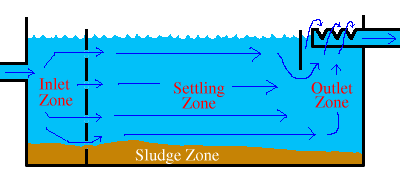
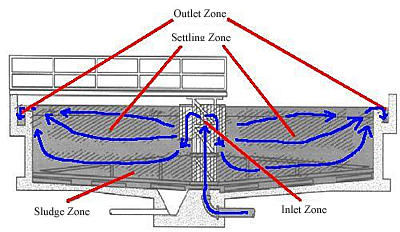
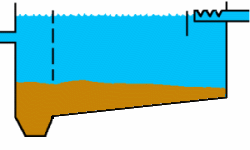
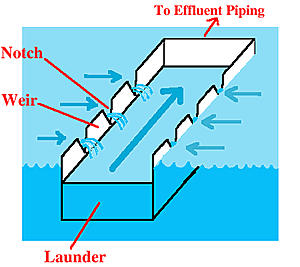
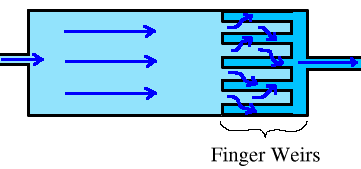
 LIKE TO GET UPDATES
LIKE TO GET UPDATES  TO GET EXPERT GUIDE
TO GET EXPERT GUIDE